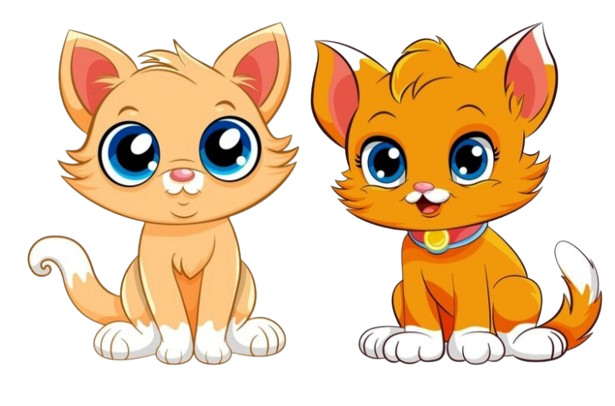Devon Rex Cat
History
The Devon Rex breed was first bred in 1960. The father of
the Devon breed, a wild, curly cat, lived around an abandoned tin mine near
Buckfastleigh, a small town in Devonshire in southwest England, which borders
Cornwall, the birthplace of the Cornish Rex.
The curly cat is paired with a female shorthaired cat. As a
result, there were kittens, which were found by a resident of the town - Beryl
Cox. One of the kittens, a brownish-black male, had the same short curly hair
as his father. This kitten Beryl is called Kirley (English: curly).
At first, it was believed that the kitten, shared the same genetic composition as Cornish Rex because the native Cornish was near the
county of Devonshire, but test breeding soon found that the kitten was unique,
that is, had a unique genetic composition as a result of a natural genetic
mutation.
The first Devon Rex was imported into the United States in
1968. In 1972, ACFA became the first U.S. association to accept the breed for
the championship. Devon Rex was adopted by TICA in 1979 (the year TICA was
formed). The CFA took Devon Rex to the championship in 1983. Today, all North
American cat associations are taking the Devon Rex breed to championships.
Characteristics of the breed
Adaptability 10/10
Attachment to the family 10/10
Gaming activity 10/10
intelligence 10/10
General health 06/10
Wool fallout 01/10
Friendliness to children 08/10
Friendly to dogs 10/10
Love for meows 02/10
Breed information
|
The Origin |
United Kingdom |
|
lifetime |
10-15 years old |
|
size |
Average |
|
weight |
Cats: 3.5-4.5 kg, Cats: 2.5-3.5 kg |
|
The type of wool |
shorthaired |
|
Color |
any colors and drawings of wool |
|
lifestyle |
Outdoors / indoors |
price |
150-400 $ |
Description
Devon Rex is a very smart, unique-looking breed of cat,
known for its wavy hair and big ears. Protruding cheekbones and huge ears create
a characteristic elven appearance. The body is muscular, medium length, and has
a wide chest.
Their silky, wavy coat can be of any color. The eyes of
Devon Rex have different color shades and variations.
Devon Rex is a relatively small cat, males weigh between 3.5
and 4.5 kg and females weigh from 2.5 to 3.5 kg. Their life expectancy is 10
to 15 years.
The breed is often associated with the fact that they are
one of the most hypoallergenic cats because of their type of wool. However,
they are not technically hypoallergenic.
Personality
Devon Rex is an incredibly intelligent breed of cat known
for its playfulness and activity - some even call it a "monkey in a cat
costume." They like to jump, so it would be nice to hide any fragile
things where the cat cannot get.
Anything that can be lifted or moved becomes a toy or a
Devon Rex target. Vigilante and active Devon rex show a keen interest in
everything that is and happens around it.
Unlike many breeds of cats, Devon Rex is well trained, so it
can be taught to walk on a leash, as it is done in Maine and Bengal
cats well as playing in the trap and learning such tricks as sitting and jumping like
a dog.
Devon Rex is also known for their tenderness - they love to
be close to their hosts and can even be seen on the shoulders of their loved
ones. They are attentive and sociable and are happy to follow their family
around the house during the day.
Due to its playful, sociable nature, it is a good choice for
families with adult children, other pets, or frequent guests. Devon Rex is a
good traveler and a great cat for therapy.
Common Diseases
Devon Rex is generally a healthy breed of cat, but the
health problems that have been seen in the breed are the following:
hypertrophic cardiomyopathy (HCM);
dislocated hamstring;
a condition called hereditary myopathy, which affects muscle
function.
Hypertrophic cardiomyopathy (HCM) common type of heart
disease in cats. This causes thickening (hypertrophy) of the heart muscle. An
echocardiogram can confirm whether the cat has HCM.
Dislocation of the pate is a hereditary problem in which the
kneecap sometimes falls out of place, causing the cat to limp or jump. Usually, it returns to its place on its own, but in serious cases, it can often or even
permanently dislocate and may require a surgical correction.
Devon rex myopathy. The hereditary condition, which begins
to manifest at the age of 3 weeks to 6 months, causes muscle weakness and
lethargy. In this case, there is no treatment and the severity of the condition
can vary.
Care
Regularly take care of the kitten, take baths, clean it
and trim the claws.
On the skin of some cats may appear oily sensation,
especially in folds or on the paws. If this is the case, bathe your pet every
few weeks.
The rest is basic care. Trim its claws every week or so and
brush the teeth with veterinarian-approved toothpaste for pets. Check his ears
weekly. If they look dirty, wipe them off with a cotton swab soaked in a soft
ear-washing agent recommended by your veterinarian.



